New Construction project in Concord MA. Forest Keepers are called in for a tree preservation job. Three beautiful, majestic Sugar Maple trees stand resident in the midst of this new development. The developer loves the trees and wants to keep them as healthy as possible since they are the focal point of the whole project.
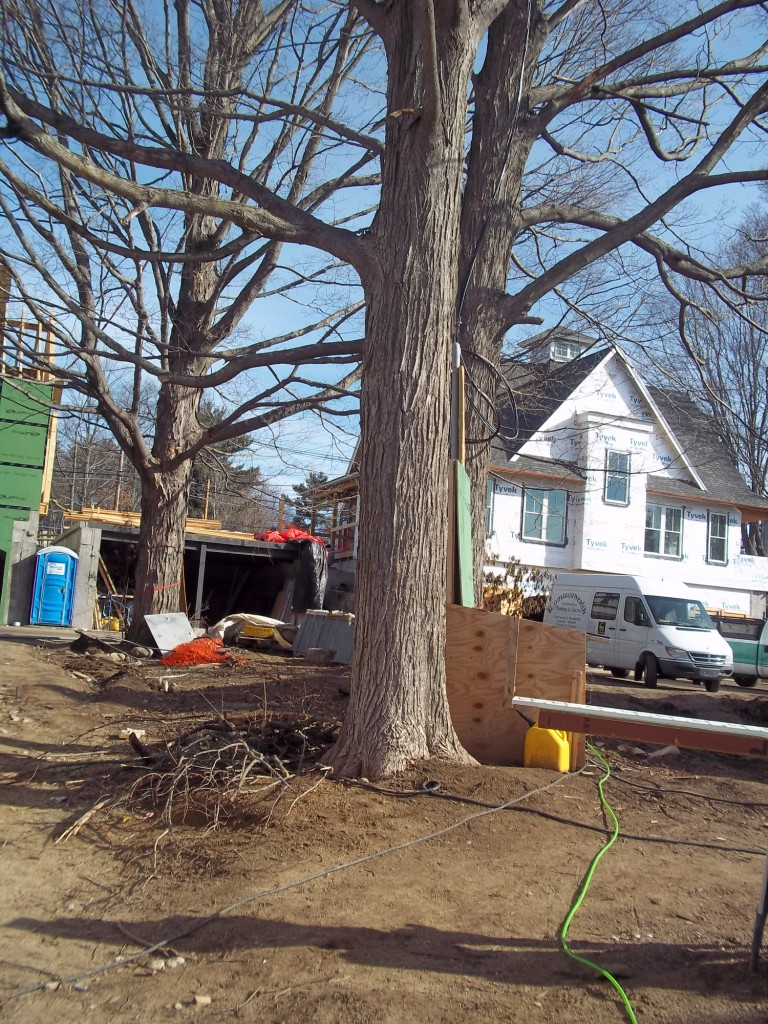
You can see here that these three Sugar Maples are remarkable trees but were suffering in the middle of a construction site.
So this is the scenario. And it is a sadly typical one. I can say that it is to the developers credit that he wanted to save these trees and was willing to hire some professional arborists to see to it, but as is often the case, the call was made a bit late in the game. Too late? Well, with some intervention and some good old TLC, we’ll see if our tree preservation efforts can pull these trees out of the distress that they are in.
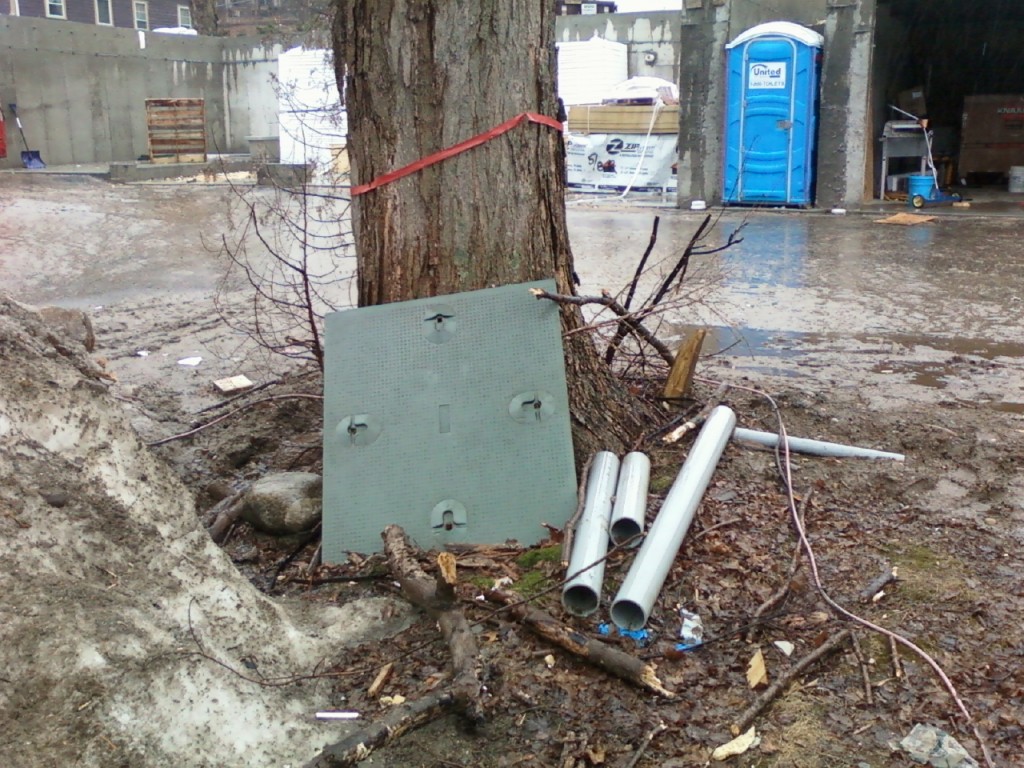
he site conditions for the Maple trees were not to good. Extra materials and garbage were piled up around the base of the trees, not to mention the condition of the soil. Notice the lack of drainage in this picture.
The processes involved with construction can be devastating to surrounding trees if no measures have been taken to protect them. The visible injuries such as broken limbs and wounds to tree trunks are only the beginning, and in fact, as you can see in these photos, somehow the contractors on this site have done a great job making sure that the trees have suffered no visible, physical wounds. Most likely, this is because of the concern that the developer had for these trees. Unfortunately, however, it is not the damage that you easily see that is most detrimental to the trees. It is the damage to the root systems that often result in tree loss. Soil compaction is a notorious tree killer!

What was once a thick layer of life giving, forest soil has now been turned into a stripped and lifeless urban hard pan. With it’s chemistry significantly altered by concrete run off, and depleted of it’s rich mulch of leaf litter and hummus, this soil will not be able to sustain the life of these magnificent Maple trees.
SOIL COMPACTION KILLS TREES!
In an ideal situation, an arborist would be called in to consult in the planning stages of construction, when the appropriate precautions and tree preservation measures can be worked right into the site plan. But alas, as it so often happens, no such plans were made and now these beautiful Maples have had the great misfortune of countless heavy machines and far too much foot traffic, pounding all of the precious biology and soil pores out into oblivion.
But there is hope!
First off we need to aerate the soil and try to get some structure back for those poor, suffocating root hairs. For obvious reasons, tilling the earth by most conventional methods would prove disastrous for any tree as the roots would not likely survive the ordeal. Thankfully for this we have a great tool at our service. The Air-spadeis a tool that uses compressed air at high pressures to move soil without affecting any solid object in the soil. Yes even tree roots. Not even the fine textured root hairs that are responsible for water and nutrient uptake are harmed by this lifesaving tool.

To alleviate soil compaction, we used the air-spade tool to loosen the soil around the Maple trees. As the soil structure is corrected, this will give the tree roots the micro-pores they need to put out new root hairs that will help nourish and draw water for the rest of the tree.
Next we need to get some much needed organic matter back into this devastated soil!

A nice layer of compost is spread out over as much of the root zone as possible, reintroducing the much needed organic mater.

Only the finest compost will do for these trees!
Only the best!
This is some of the best compost being produced that we know of in the Northeast. PhaseII Stormwater products Inc., a division of Groundscapes Expresshas been producing some of the finest, most reliable compost for years.
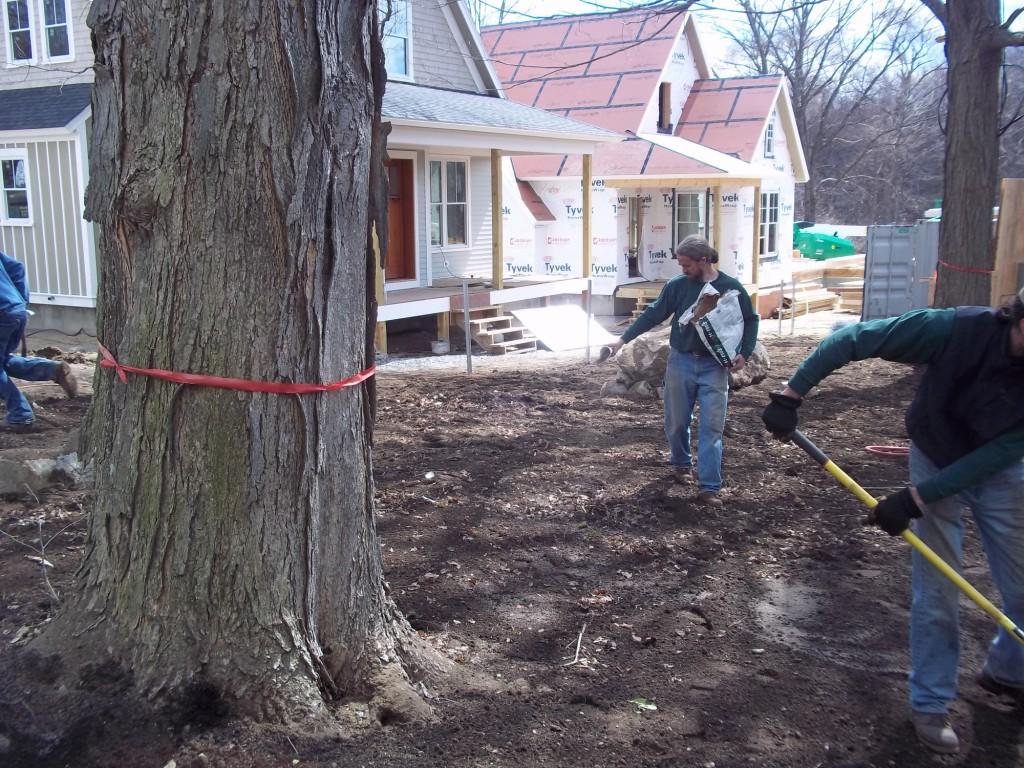
To stimulate new root growth and to add to the soil biology, we added an organic bio-fertilizer. When it comes to root health you always want to use a product that is full of mycorrhizae and many other beneficial microbes. It took quite a few pounds for these trees to say the least!

Next, the compost is tilled into the top layer, giving the soil the organic materials that it needs and helping to maintain the proper soil structure. Note the difference in soil just next to tilled area by the foundation of the new building.
On top of the newly aerated and revived soil we added a healthy layer of bark mulch and clean leaf litter. This will help to regulate soil moister and temperatures, as well add just one more layer of organic material that forest trees are so accustomed to having. You could say that we have essentially re-potted these Maple trees in the closest that we could create to a healthy forest soil.
Now we just need to keep everybody off of the protected root zone!
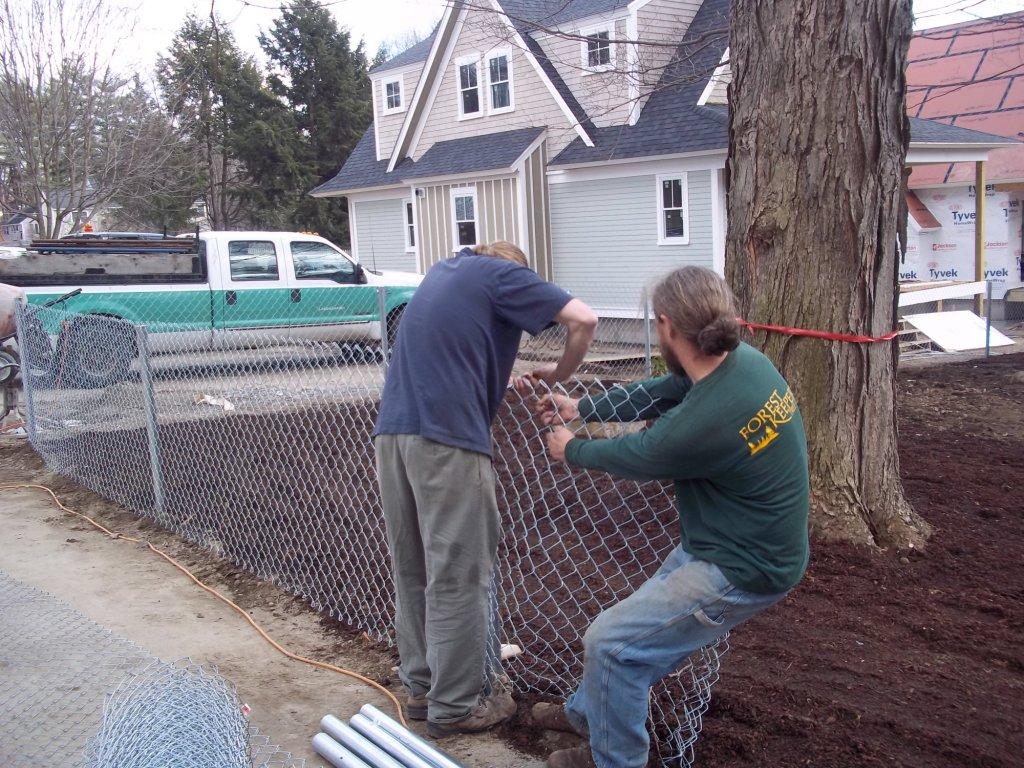
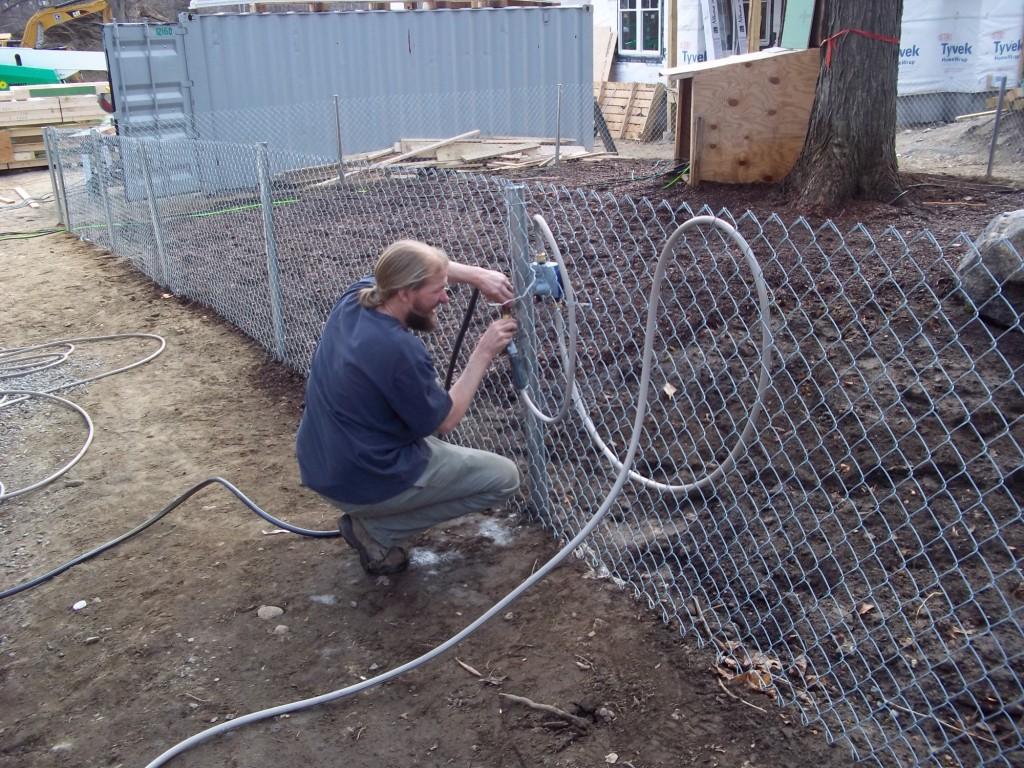
BEFORE! AFTER!

he site conditions for the Maple trees were not to good. Extra materials and garbage were piled up around the base of the trees, not to mention the condition of the soil. Notice the lack of drainage in this picture.

After work was complete you can see the improved conditions for the tree.
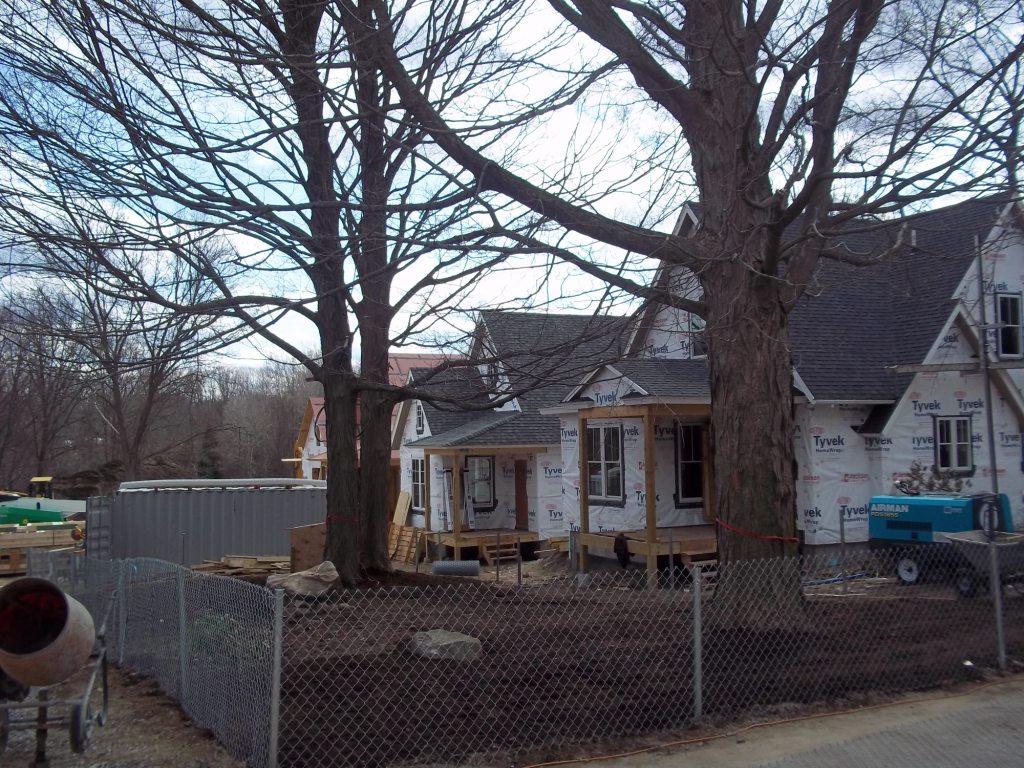
These trees are in a much better condition now.

Comments
Pingback: How to save trees on construction sites | Treeblogging.com
Wow! What an operation. Sugar maples are so sensitive to damage and adverse conditions, that I wonder if these will be okay. But you certainly have made every attempt to get them back to happiness. They got everything they could want — air, mulch, water, fencing. It is so good to see this concern from a construction company.
We had an arborist use the air spade on our red maples that were planted too deeply (yes, a “landscaper” put them in), and did they ever perk up that following season!
Yes Sugar Maples are pretty sensitive. They especially don’t like change when they have already been established in a certain situation for many years. We are going to do a couple follow up visits this spring to keep track of how they are doing. We are hoping for the best.
Please post some follow-up photos of these trees, if possible, as you check up on them.
I would be so interested to see…
Connie, I sure will post some follow up photos on this project later this spring. Stay tuned!
There is more landscaping to be done around these trees but it all will be done by hand. NO MACHINES! I am interested in how these Maples have responded to the treatment. It is a shame when builders kill the very trees they are building around. Many people have this misconception that old, large trees must be so strong that nothing will affect them. Oh well!
This blog must be read by all New York city people. For example, I feel so terrible for the trees on 2nd avenue where the 2nd avenue subway is coming. Also nobody thinks of the trees in Manhattan where there is constant construction. If only Mayor Bloomberg would make ‘destruction of a tree’ a crime punishable by $100,000 since all contractors and owners of buildings, Verizon and Con Edison, MTA have that kind of money to pay. It is a rare contractor that even wraps the base of a tree before they start digging or contaminating the site.
Shirley, I appreciate your passion about this topic. I agree with you that if people really understood the value of trees in our communities they would certainly do more to protect them from inadvertent and premature destruction.
There is a great book called Up By Roots by James Urban./ It goes into great detail on how and why we should actually design healthy soils and trees in to our urban landscapes, giving full weight to all of the social and economic value that healthy trees will undoubtedly create. As an arborist it is quite bothersome when I see the streets of some township or city, lined with sickly and forsaken trees.
Great work! Reminds me of the efforts that were made to save live oak trees when they did a big construction project on the island where I used to live in Georgia. They actually temporarily transplanted the trees to another part of the island temporarily in giant wooden planters, intending to put them back when the construction was done (photos here – http://rebeccainthewoods.wordpress.com/2010/12/12/trees-in-boxes/). I moved away before they finished, so I don’t know how many of those trees survived, if any.
Nice! Glad all that effort was put into saving those big boys! It always kills me a little (lot) inside when I see that not happening. Hope they remain healthy!
http://nutcase007.blogspot.com/
Yes it bothers me too when I see trees getting neglected in situations that I know full well could be remedied.
Oh and by the way, I just visited your web site. Amazing photos!
Nice work, I look forward to following your blog posts to see more of your photography.